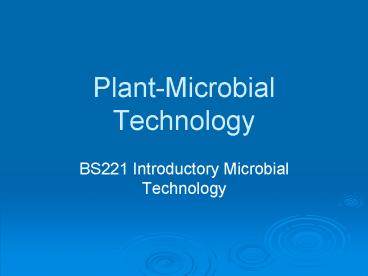PlantMicrobial Technology - PowerPoint PPT Presentation
1 / 24
Title:
PlantMicrobial Technology
Description:
Use of agrobacterium for plant genetic modification ... Enzymes. Inhibitors. Engineering strategies. Single gene transfers. Protoplast fusion ... – PowerPoint PPT presentation
Number of Views:260
Avg rating:3.0/5.0
Title: PlantMicrobial Technology
1
Plant-Microbial Technology
- BS221 Introductory Microbial Technology
2
The control of plant disease
- Cultural methods
- Disease-resistant plant varieties
- Agrochemicals
- Genetic modification of plants
3
Plant Microbial Technology Topics
- Biology of agrobacterium
- Use of agrobacterium for plant genetic
modification - Genetic modification of plants to resist disease
- Biological control of agrobacterium
- Viruses as gene vectors
4
Plant - Microbial Technology references
- For lecture summaries and this PowerPoint
presentation see the BS221 section of my homepage
at http//www.homepages.uel.ac.uk/J.Mottley - Dines, A. Mottley, J. (1999). Seeds of Change
Applications of Biotechnology to Agriculture. In
(Springham, D.G. Moses, V., eds) Biotechnology
The Science and the Business. Harwood Academic
Publishers, Chapt. 23, pp. 465-499. - http//homepages.uel.ac.uk/J.Mottley/Newchapt.html
- Information Systems for Biotechnology (Searchable
database). http//www.nbiap.vt.edu/
5
Plant Genetic Modification
- PURPOSE to make plants more useful
- TRADITIONAL BREEDING
- Genes are usually transferred only between
members of the same species by cross-pollination.
Therefore, normal plant functions are made more
effective. - MODERN METHODS
- Genes from any organism can be introduced into
plants so that they perform completely new
functions.
6
(No Transcript)
7
(No Transcript)
8
(No Transcript)
9
Engineering the Ti plasmid
Remove natural T-DNA genes
Selector gene
Oncogenes
Opine synthesis genes
Reporter gene
Useful gene
Border sequence
Replace with modified ones
L
R
T DNA
Ti plasmid
Infect wounded plant cells with agrobacterium
containing modified Ti plasmid
T-DNA integrates useful gene into plant genome
and the plants also become inhibitor-resistant
(from selector gene) and shows expression of
reporter gene
10
(No Transcript)
11
Gene promoters
- Constitutive
- Tissue-specific
- Inducible
12
Marker genes
- Selector genes
- Antibiotic r
- Herbicide r
- Reporter genes
- Luciferase
- ?-glucuronidase (GUS)
- Green fluorescent protein (GFP)
13
Regeneration of Genetically Modified Plants from
Tissue Cultures
14
Engineering Virus resistance in Plants
- Viral coat protein genes
- Satellite RNA
- Antisense genes
- Antiviral antibody genes
15
Viral coat protein genes
- Based on principle that coat proteins of viruses
can be used to protect plants from viral disease - Plants are genetically modified with genes coding
for viral coat protein genes so that they produce
the coat proteins - Resistance proportional to amount of coat
protein produced in cells so may be due to - Blockage of specific binding sites on plant cell
surface? - Blockage of enzyme active sites responsible for
uncoating the viruses before infection
16
Satellite RNA
- Uses satellite RNA found in a few single-stranded
RNA viruses, eg. CMV, TobRV - The satellite RNA may supress (symptom-suppressing
RNA) or enhance (symptom-enhancing RNA) of the
disease caused by the virus - Symptom-suppressing RNA is isolated and cDNA
copies used to transform plants so that they
produce the RNA
17
Protein synthesis
A
T
G
C
3
5
Gene (Double stranded DNA)
Natural promoter
5
T
A
C
G
3
Transcription
Single stranded mRNA
Ribosome
Translation
Gene expression
Protein
18
Antisense gene technology
A
T
G
C
3
5
Gene (Double stranded DNA)
Natural promoter
5
3
T
A
C
G
Transcription
Single stranded mRNA
Ribosome
No Translation
mRNA strands hybridise to become double-stranded
duplex
No Gene expression
No Protein Gene is silenced
C
Transcription
A
T
G
Gene (Double stranded DNA) Multiple copies)
5
Strong Promoter
5
3
T
A
C
G
19
Antiviral antibody genes
- Plants are transformed with genes that code for
antibodies against specific viruses - An example is the transformation of Nicotiana
benthamiana to produce antibodies against the
artichoke mottled crinkle virus
20
Antiviral antibody technology
Cell culture
AMC virus
Mouse myeloma cells
Anti-AMCV antibody producing lymphocytes
Infect mouse
reverse
Plant
Anti-AMCVmRNA
Anti-AMCV cDNA
transcription
Anti-AMCV antibodies
Agrobacterium Ti plasmid
Transformed plant
Anti-AMCV mRNA
21
Use of Viruses for Gene Transfer
- Caulimoviruses
- Gemini viruses
22
Caulimoviruses
- Contain double-stranded DNA, eg. cauliflower
mosaic virus (CaMV) - Can be engineered then infected by simply
wounding and smearing - Rapid systemic infection, replicated and
expressed - But NOT integrated into host genome (so not
inherited through seeds) - Host range limited to Brassica family (cabbages)
23
Gemini viruses
- Small group of single-stranded DNA viruses, eg.
maize streak and wheat dwarfing - Can only be transmitted by insects, eg. whitefly
and leaf hoppers - Not integrated into host plant genome
- Wide host range, eg. legumes, cereals and
potatoes
24
Engineering Resistance to Fungal Diseases
- Natural defence systems
- Structural defence
- Enzymes
- Inhibitors
- Engineering strategies
- Single gene transfers
- Protoplast fusion































